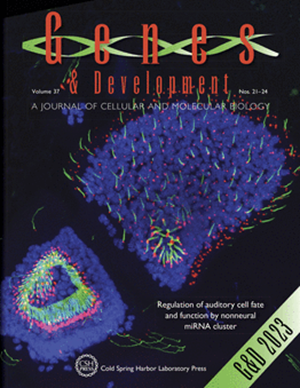An intrinsically disordered region of Drosha selectively promotes miRNA biogenesis independent of tissue-specific Microprocessor condensates
IF 7.7
1区 生物学
Q1 CELL BIOLOGY
引用次数: 0
Abstract
Precise control of miRNA biogenesis is of extreme importance, because misregulation of miRNAs underlies or exacerbates many disease states. The Microprocessor complex, composed of DROSHA and DGCR8, carries out the first cleavage step in canonical miRNA biogenesis. Despite recent advances in understanding the molecular mechanism of Microprocessor, the N-terminal region of DROSHA is less characterized due to its high intrinsic disorder. Here we demonstrate that Microprocessor forms condensates with properties consistent with liquid–liquid phase separation (LLPS) in select tissues in Caenorhabditis elegans. Although DRSH-1/Drosha recruitment to granules is only partially dependent on its intrinsically disordered regions (IDRs), one of these N-terminal IDRs is crucial for biogenesis of a subset of miRNAs and normal development. A cis region of IDR-dependent miRNAs confers IDR dependence to another miRNA, suggesting that the IDR recognizes sequences or structures in the miRNA primary transcript. Future studies will further elucidate the specificity of this interaction and the putative role of Microprocessor condensates.Drosha的一个内在紊乱区域选择性地促进miRNA的生物发生,而不依赖于组织特异性微处理器凝聚物
精确控制miRNA的生物发生是极其重要的,因为miRNA的错误调节是许多疾病状态的基础或加剧。由DROSHA和DGCR8组成的微处理器复合体在标准miRNA生物发生中执行第一步切割。尽管近年来对微处理器分子机制的理解取得了进展,但由于其高度的内在无序性,DROSHA的n端区域的特征较少。在这里,我们证明微处理器在秀丽隐杆线虫的特定组织中形成具有与液-液相分离(LLPS)一致性质的凝聚体。尽管DRSH-1/Drosha向颗粒的募集仅部分依赖于其内在紊乱区域(IDRs),但这些n端IDRs之一对于mirna子集的生物发生和正常发育至关重要。IDR依赖性miRNA的顺式区域赋予另一个miRNA IDR依赖性,这表明IDR识别miRNA主要转录物中的序列或结构。未来的研究将进一步阐明这种相互作用的特异性和微处理器凝析物的假定作用。
本文章由计算机程序翻译,如有差异,请以英文原文为准。
求助全文
约1分钟内获得全文
求助全文
来源期刊

Genes & development
生物-发育生物学
CiteScore
17.50
自引率
1.90%
发文量
71
审稿时长
3-6 weeks
期刊介绍:
Genes & Development is a research journal published in association with The Genetics Society. It publishes high-quality research papers in the areas of molecular biology, molecular genetics, and related fields. The journal features various research formats including Research papers, short Research Communications, and Resource/Methodology papers.
Genes & Development has gained recognition and is considered as one of the Top Five Research Journals in the field of Molecular Biology and Genetics. It has an impressive Impact Factor of 12.89. The journal is ranked #2 among Developmental Biology research journals, #5 in Genetics and Heredity, and is among the Top 20 in Cell Biology (according to ISI Journal Citation Reports®, 2021).
 求助内容:
求助内容: 应助结果提醒方式:
应助结果提醒方式:


